Overlooked mechanisms behind seismic damage
DOI: 10.1063/PT.3.4655
On 17 January 1995, a devastating earthquake struck the port city of Kobe in southern-central Japan and the densely populated surrounding area. The quake, officially named the Hyogo-ken Nanbu earthquake, had a moment magnitude of 6.9. The seismic rupture initiated at a shallow depth of 16 km and propagated to the northeast and southwest along the crust’s local geological fault system (figure
Figure 1.

(a) The 1995 Hyogo-ken Nanbu earthquake near Kobe, Japan, produced structural failures throughout the area and at the specific locations indicated. (Adapted from topographic map provided by Geospatial Information Authority of Japan and ref.
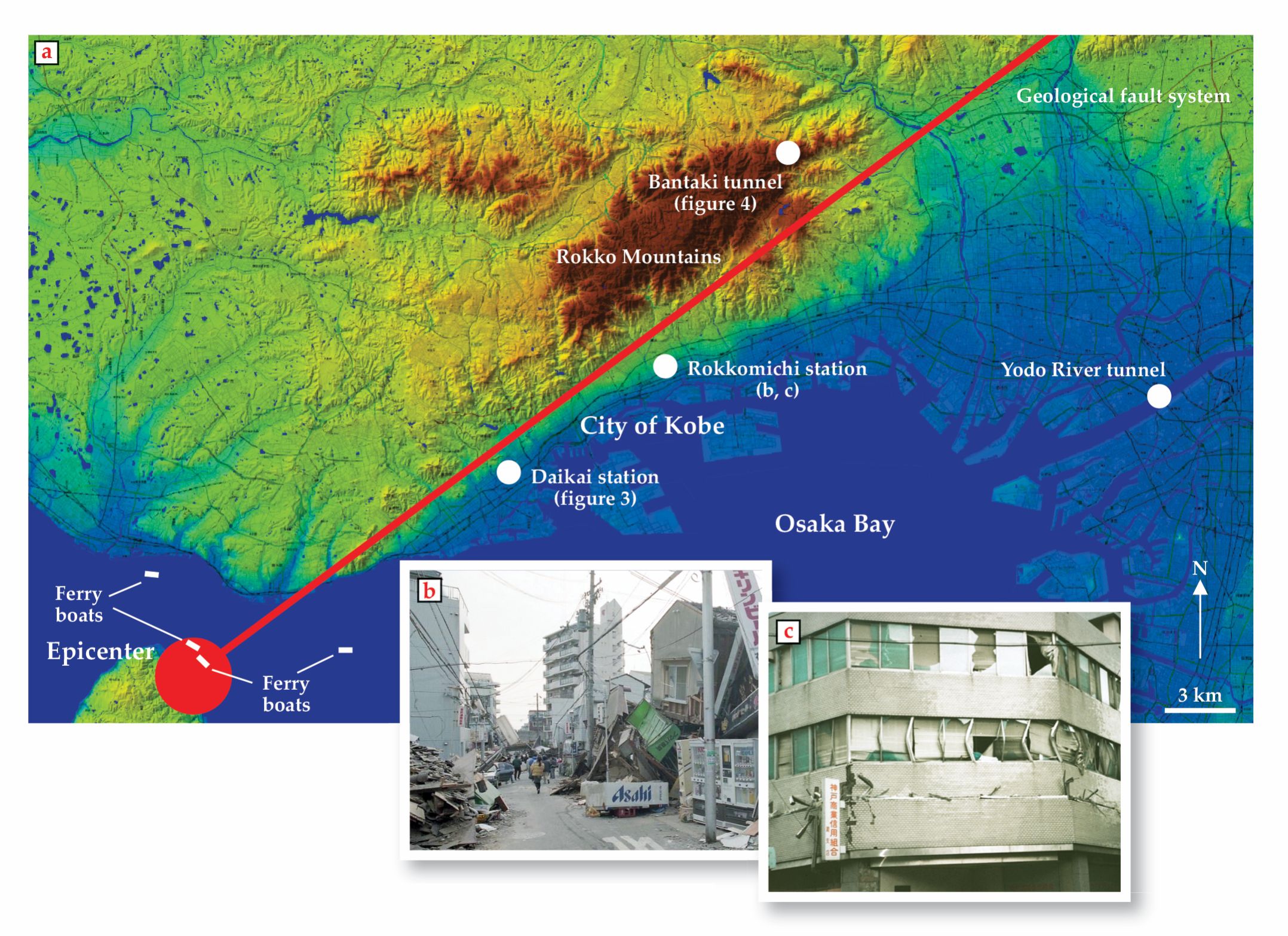
What made the Kobe event unusual was that seismic rupture—the slipping in Earth’s crust—propagated along a fault that ran directly through a developed area with a population of more than three million. The distance between the city center and the earthquake’s epicenter was only about 20 km; often it’s hundreds of kilometers or more because most cities are located farther from geologic faults. The Kobe area was therefore directly hit by strong seismic waves that hadn’t yet attenuated through propagation. The quake totally or partially destroyed approximately 640 000 buildings throughout the area.
The photograph in figure
That wasn’t the case everywhere, though. Surprising structural damage was found in RC buildings around Kobe. Figure
Seismic waves and structural vibrations
To understand how the Kobe earthquake caused such damage to supposedly earthquake-resistant RC buildings, we first consider the basic characteristics of typical seismic waves. In a linear elastic solid like Earth’s crust, the force per unit area, or stress, in the material is linearly proportional to the local deformation per unit length, or strain.
1
Continuum mechanics accommodates two types of body waves, primary longitudinal (P) and secondary shear (S) waves. P waves propagate the fastest, and they cause the ground to move parallel to the direction of the wave’s propagation (figure
Figure 2.

(a) A longitudinal (P) wave moving through a solid medium generates compressive and extensional motions that cause local volumetric changes in the medium. The wave moves at a constant speed through the medium. (b) A shear (S) wave, which travels at a constant speed smaller than that of a P wave, produces transverse or shearing motion that doesn’t cause volumetric change.
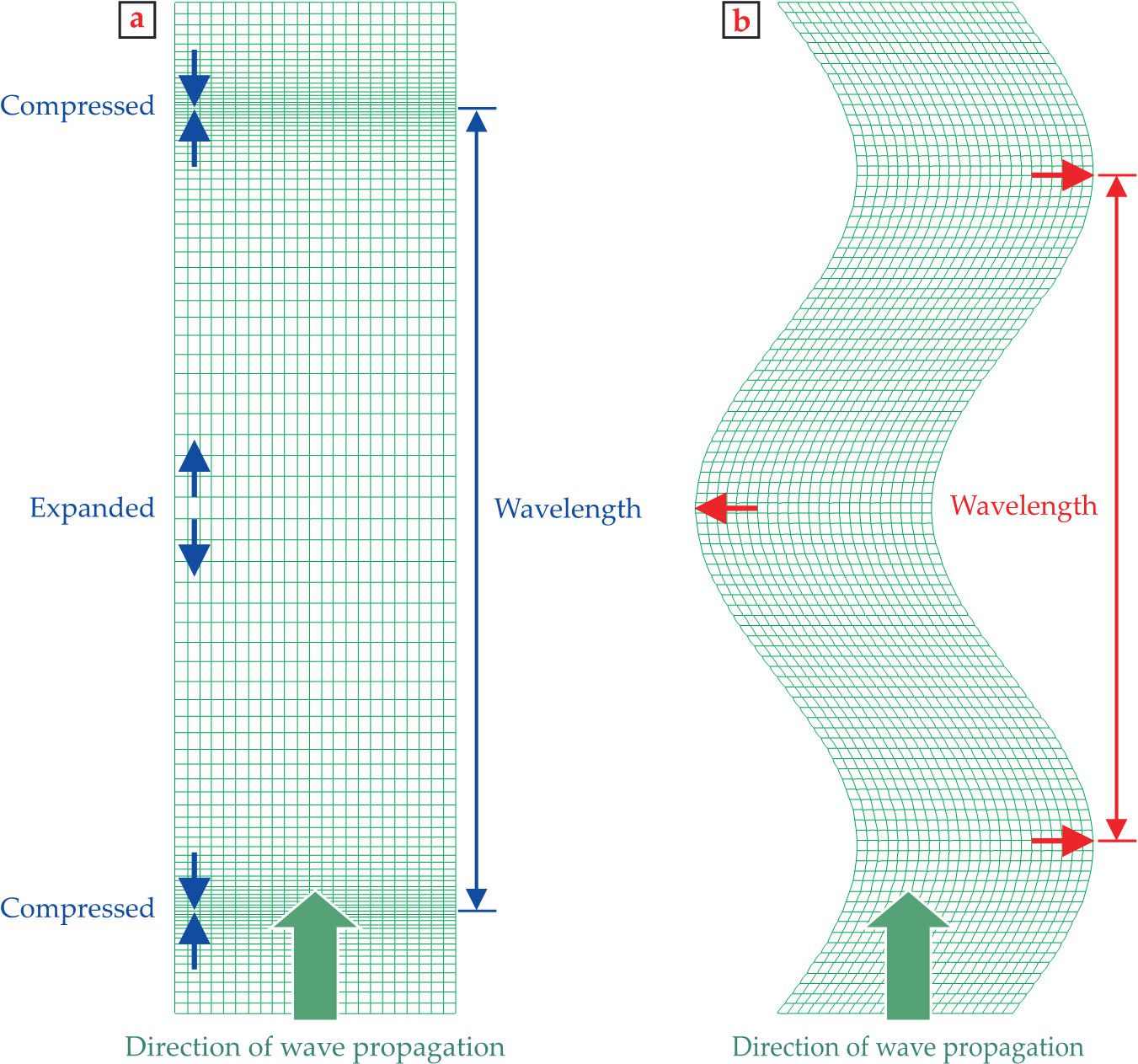
In addition to body waves, earthquakes also generate surface waves, typically Rayleigh (R) waves. R waves moving along a stress-free boundary like Earth’s surface induce both horizontal and vertical shaking at the surface. They also attenuate more slowly than body waves as they propagate: The amplitude of an R wave decreases as
A wave’s attenuation is also affected by its frequency. Lower-frequency waves propagate farther and with less attenuation than higher-frequency ones. High-frequency P and S waves should therefore be more abundant in seismological recordings near an earthquake’s focus. On the other hand, if a seismograph is installed far from the focus, lower-frequency R waves dominate the recorded shaking.
Seismologists have used the fundamental characteristics of waves described above to derive relationships between the shaking recorded by seismographs and the invisible waves that radiate from earthquake hypocenters. (See the article by Hiroo Kanamori and Emily E. Brodsky, Physics Today, June 2001, page 34
Engineers, on the other hand, are often concerned with earthquakes’ effects on natural and artificial structures like slopes and buildings, whose relevant length scales range from a few to hundreds of meters—far smaller than Earth’s interior structures. Low-frequency seismic waves are much longer than those structures, so their detailed features are usually not considered when designing buildings and testing their earthquake readiness. Instead, the vibrations recorded at nearby seismological stations are low-pass filtered, and target structures under test are subjected only to low-frequency horizontal vibrations. Both vertical shaking from P and R waves and dynamic interactions between incoming waves and the target are neglected.
The insights gained from that sort of conventional engineering have been invaluable. However, localized structural failures whose length scales are on the order of meters or tens of meters, like that in figure
Unexpected, then forgotten
Underground structures are generally believed to be sufficiently strong against earthquakes. And usually they are. But in 1995, the Daikai railway station in downtown Kobe catastrophically failed. At the station, about 5 m below ground, vertical collapse of the reinforced concrete columns supporting the roof (figure
Figure 3.

The underground Daikai station in Kobe, Japan, collapsed during a 1995 earthquake. (a) The reinforced concrete columns supporting the roof gave way and (b) the street above the station sank in a 100 m × 20 m area; in some places, it fell as much as 2.5 m. The failure disproves the myth that underground structures are safe against earthquakes. (Photographs courtesy of Shunsuke Sakurai, Kobe University.)
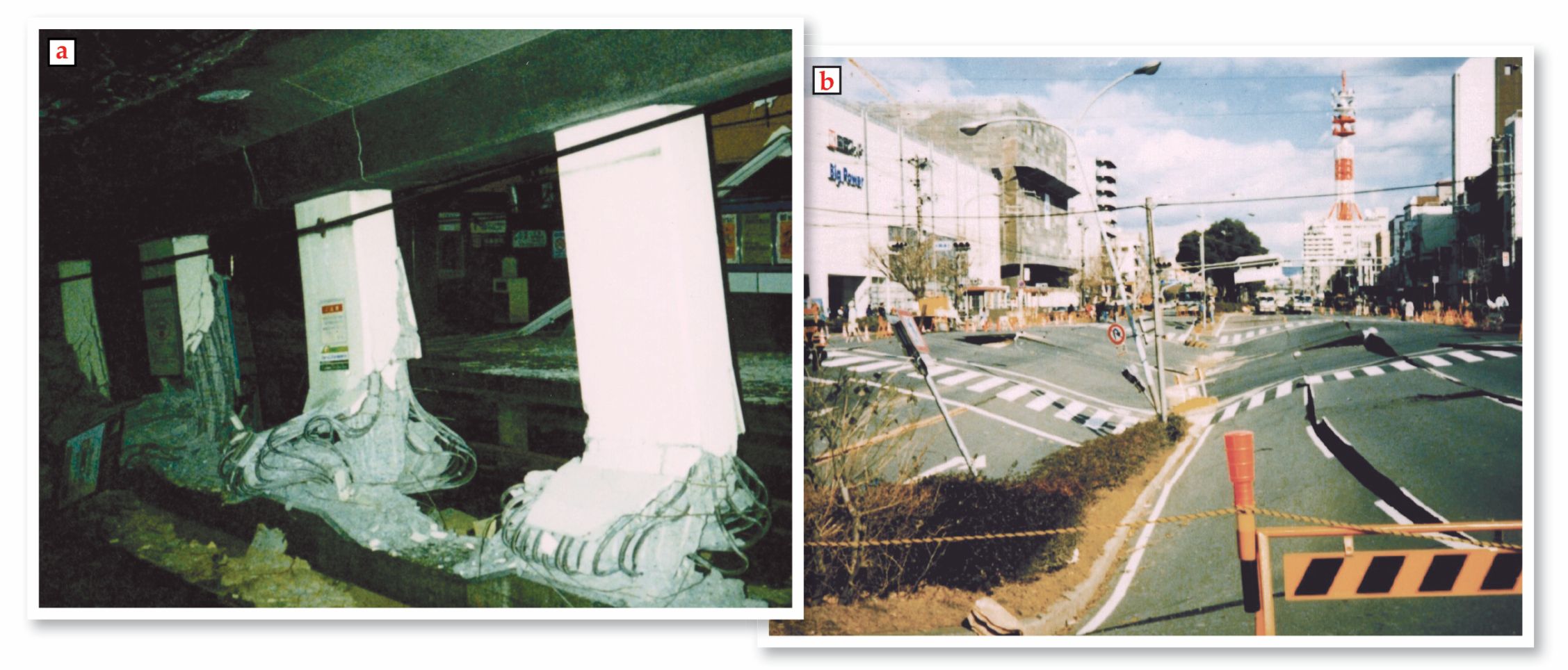
The central section of the approximately 1750-m-long Bantaki road tunnel through the Rokko Mountains was also damaged. The concrete wall, which was reinforced with steel bars, fractured from compressive force, and the road surface jumped up from the underlying concrete, known as the invert (see figure
Figure 4.

The Bantaki tunnel experienced unfamiliar structural damage during the Hyogo-ken Nanbu earthquake. A high-frequency P wave impinging on the tunnel could have caused vertical shaking that dynamically compressed the tunnel and caused the failure observed in Bantaki—namely, the fracture of the concrete wall and the detachment of the road from the tunnel’s underlying concrete. An S wave with horizontal vibration could not have produced the necessary compressive force in the tunnel’s wall. (Photographs courtesy of Shunsuke Sakurai, Kobe University.)
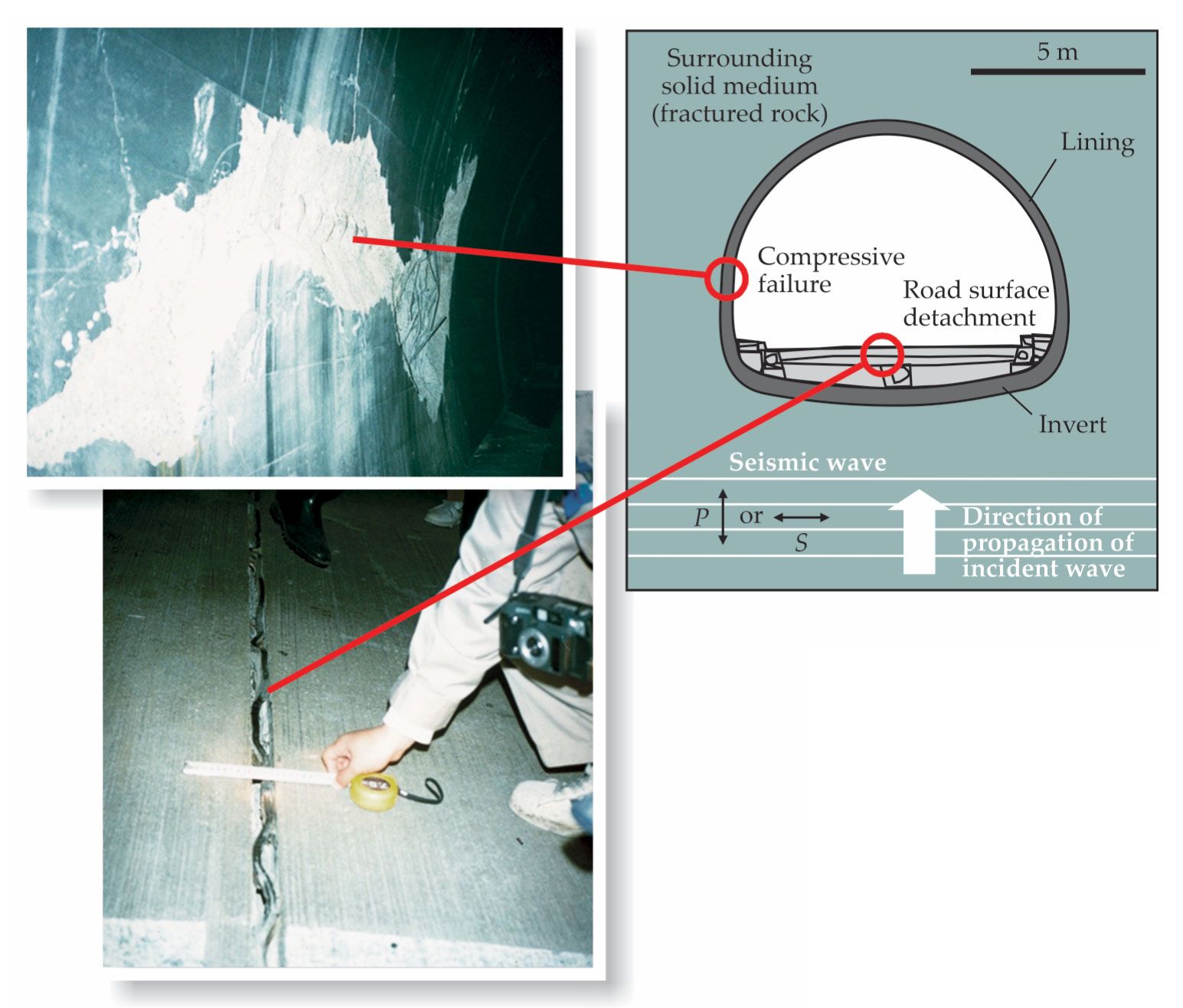
The unexpected failures at the Daiki station and the Bantaki tunnel were the first that could not be attributed to, say, instability near the portal of the tunnel; they may have been directly induced by seismic waves. Then, in 2004, a failure pattern similar to that in Bantaki was observed after the magnitude 6.6 Niigata-ken Chuetsu earthquake. The damage was observed in the near-epicenter Uonuma tunnel, which is part of the Shinkansen high-speed train system. Together, the observations support the idea that structural failures should be expected in underground structures sufficiently close to an earthquake’s epicenter.
To understand the mechanism behind the Bantaki failure, consider a P wave causing vertical shaking and an S wave causing horizontal vibrations, both propagating up toward the tunnel (figure
Simple but rigorous elastodynamic analyses confirm that if 100 Hz P waves interacted with the tunnel, the compressive vertical stress acting on the concrete lining could become more than three times as large as that in the incident wave, and the vertical acceleration would be doubled at the tunnel’s floor.
2
That stress and acceleration can explain why the tunnel’s concrete lining failed in compression and why the road surface detached in response to the earthquake. On the other hand, high-frequency S waves and conventional low-frequency waves produce much smaller vertical compressive stress on the wall and acceleration at the bottom. Hence, it seems unlikely that they generated the failures in Bantaki. High-frequency P waves are also a likely culprit for the flattened second floor in figure
The question of detection
Although the unusual structural failure patterns observed after the 1995 Kobe earthquake suggest the existence of higher-frequency vertically oscillating seismic waves, the seismographs widely installed at that time had sensitivities that fell drastically for frequencies above 20 Hz. Additionally, shaking over 10 Hz was filtered out in seismic analyses because of contamination by scattering off inhomogeneities. Strong high-frequency vibrations were therefore scarcely detected at Kobe (figure
Figure 5.

The Fourier spectra of seismograms show the vibrations recorded for (a) the 1995 Hyogo-ken Nanbu earthquake and (b) the 2016 Kumamoto earthquake. Contrary to verbal anecdotes of vertical shocks during the earliest stage of seismic shaking in the 1995 event, a seismogram recorded in Kobe, just 16 km from the epicenter, suggests that the up and down vibrations from P waves were weak and that horizontal shaking was dominant. However, it’s not clear that seismographs at the time would have been able to detect high-frequency vibrations. Upgraded seismographs deployed during the 2016 quake captured the arrival of stronger P waves. Dominant high-frequency vertical motion was recorded in Uki, 14 km from the epicenter. (Based on online data provided by the Japan Meteorological Agency, https://www.data.jma.go.jp/svd/eqev/data/kyoshin/jishin
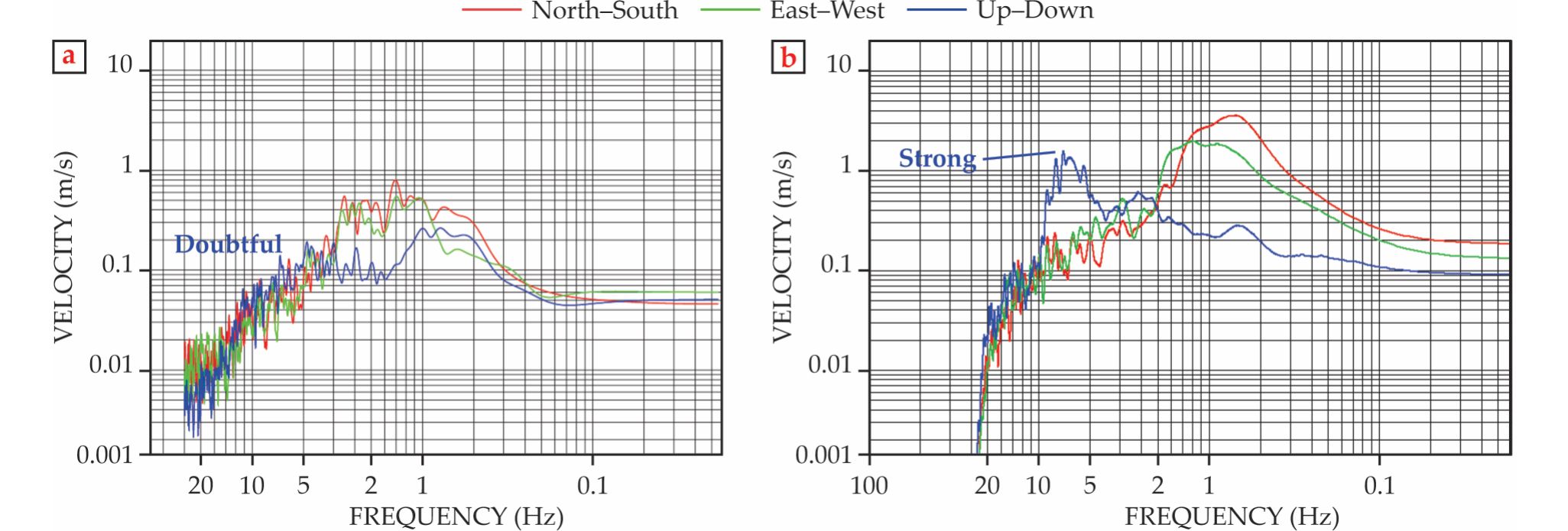
Vertical shocks were even felt on ferries (identified in figure
The failure of the concrete lining in Bantaki was nearly forgotten, and the potential importance of higher-frequency seismic waves largely ignored, until a pair of earthquakes occurred in Kumamoto in 2016. A magnitude 6.2 quake struck the city on the island of Kyushu at 9:26pm on 14 April and was followed by an even-stronger magnitude 7.0 main shock at 1:25am on 16 April. The events were enlightening because they produced clear and significant evidence of dominant higher-frequency vertical shaking near their epicenters.
As usual, horizontal vibrations prevailed below 1 Hz. But seismograms of the main shock that were recorded with upgraded seismographs in Uki some 20 km away displayed a peak in vertical shaking just below 10 Hz (figure
Evidence is still lacking for the 100 Hz waves estimated from the Bantaki failure. Even upgraded seismographs are not sensitive to seismic waves of 100 Hz, and signals become contaminated by scattering above 10–20 Hz. The signals are not impossible to record: Sensors that detect vibrations from blasting can capture frequencies up to 1 kHz. But to capture an earthquake’s signal without undue noise, specialized sensors appropriate for the frequency range and duration still need to be developed. Even though such high frequencies generated by earthquakes have not yet been recorded, it’s conceivable they exist. 4 , 6
Dynamically deformed town
Small-scale earthquake-induced failures point to a need for seismographs that are more sensitive to high frequencies. However, even horizontal vibrations well within the range being recorded can cause unusual damage on the scale of a single structure. A building or tunnel can be deformed by seismic waves, but so can an entire town.
Nearly half a century ago, an astonishingly periodic structural failure pattern was seen in Italy after the magnitude 6.5 Friuli earthquake (see
A 1976 earthquake in Friuli, Italy, produced a periodic structural failure pattern in adjacent, mechanically similar buildings. (H. P. Rossmanith, Vienna University of Technology, Austria.) Figure 6. The town effect challenges the conventional idea that earthquakes generate rigid-body shaking of unbending ground. Uniform shaking (top right) should cause the same level of vibration and damage to mechanically identical buildings; it can’t generate the alternating failure pattern in the opening image. However, S waves propagating through a densely built town can deform the ground and deliver dissimilar vibrations and damage to identical buildings (center and lower right). The frequency of the vibration determines the damage pattern. (Adapted by Donna Padian from the author’s original.)
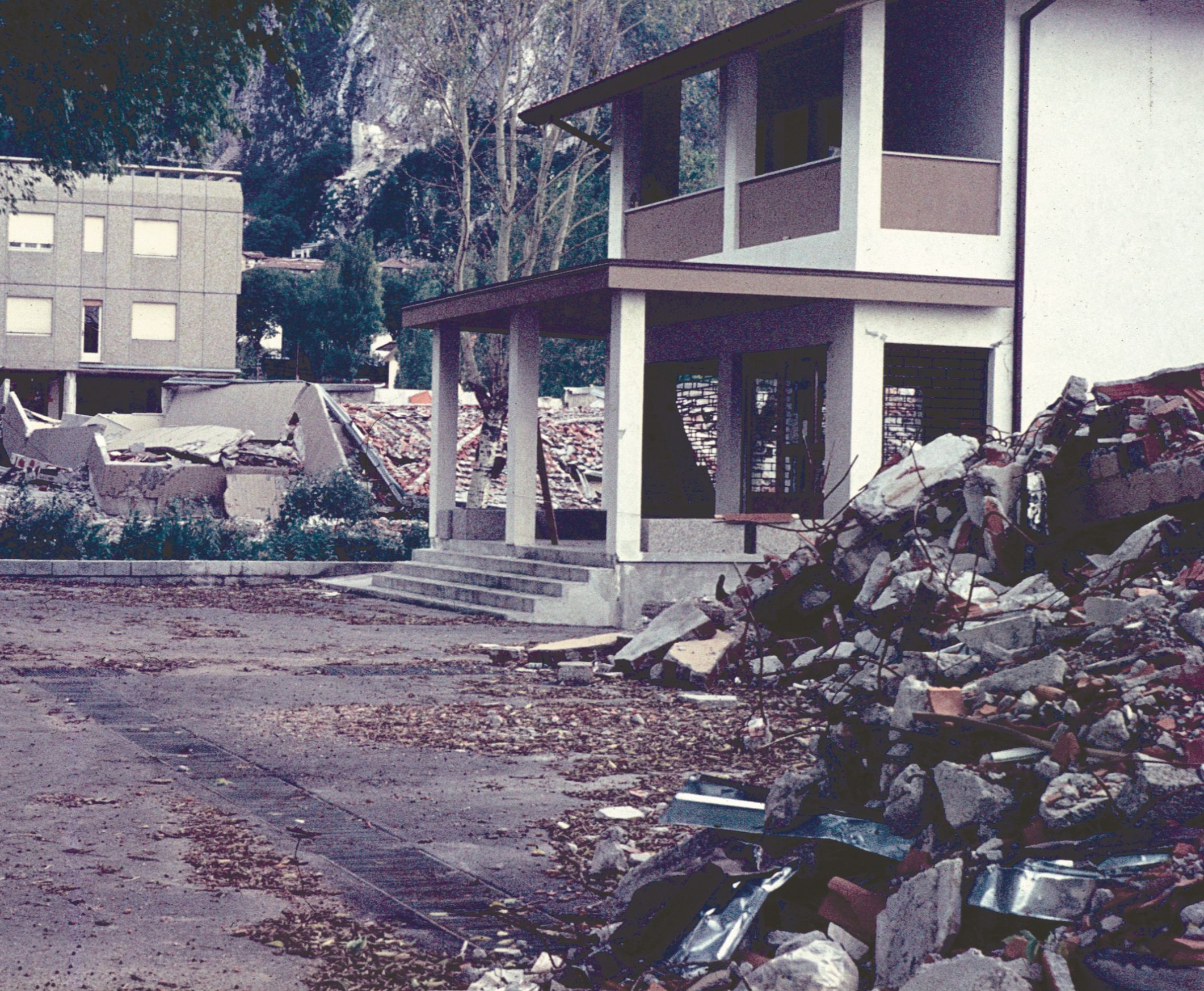

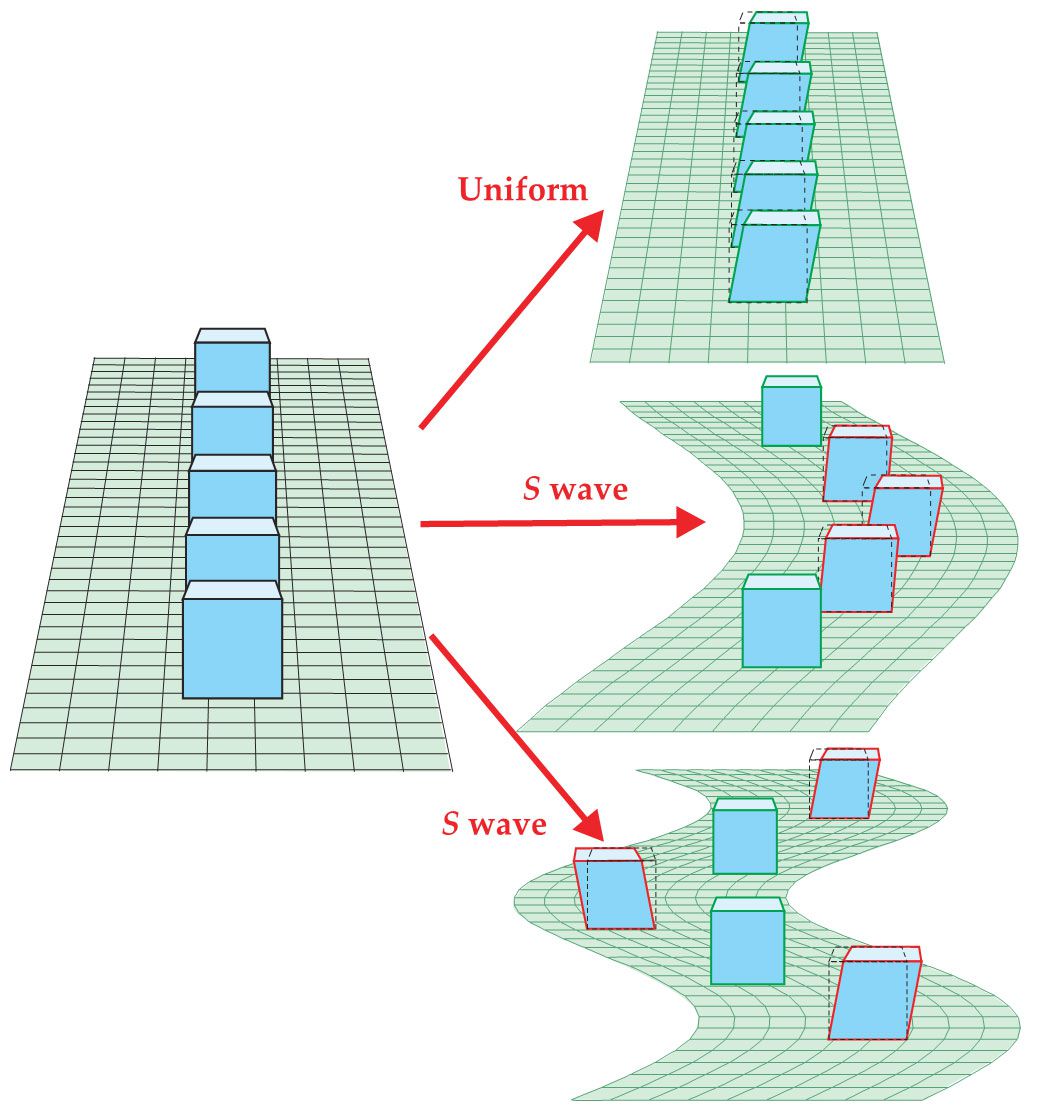
Buildings subjected to identical vibration can be endowed with different mechanical characteristics to model the nonuniform levels of damage observed in real earthquakes. But that doesn’t explain the regularly alternating damage to similar structures in the opening image. The surprising failure pattern arises naturally, however, if waves with wavelengths on the order of a few buildings are accounted for. Even if only conventional S waves with horizontal shaking are assumed, the inclusion of higher-frequency waves and the dynamic interaction between waves and the buildings results in individual buildings in a densely built town experiencing totally dissimilar vibrations.
In a town’s fundamental vibrational mode, illustrated in the center panel of figure
The idea that urban areas might interact differently with seismic waves was theoretically developed in France. It appeared after the 1985 Michoacán earthquake that generated severe damage in Mexico City. 8 Classical computational methods could not explain seismic records, and researchers wondered whether some of the seismic energy transmitted to the buildings could still affect neighboring buildings through interactions between vibrating structures and waves in the ground.
It’s hard to imagine the ground under one’s feet dynamically deforming on such short length scales. But during the 1995 Kobe event, a surveyor working in a straight, flat section of a railway tunnel 40 m below the Yodo River in Osaka, more than 40 km from the epicenter (figure
Higher or lower?
The now-dated photographs of Kobe and Bantaki point to the possibility that high-frequency seismic waves have had previously unrecognized effects on structures near earthquake epicenters. The images show damage that cannot be explained systematically using conventional low-frequency approaches. In their foundational textbook Quantitative Seismology: Theory and Methods (1980), Keiiti Aki and Paul Richards summarized classical, low pass–filtered seismology, 9 which is now intensively employed in seismic research. However, in a 2005 historical overview of the field, Aki noted that even with the improved quality and quantity of seismological data and associated computational processing capabilities, it’s hard to incorporate waves above 1 Hz into traditional low-frequency seismology models. 6
Some earthquake scientists have long acknowledged the significance of including higher frequencies in their studies. A stochastic approach to seismology developed in the 1980s incorporates Earth’s smaller-scale seismic inhomogeneities and accepts the presence of so-called coda waves, which decay slowly relative to other seismological signals. The scattering of high-frequency coda waves is used to study geological inhomogeneities. 10
Research in engineering seismology is advancing in the opposite direction—to even lower frequencies. In 2011 long-wavelength vibrations from a magnitude 9.1 earthquake off the Pacific coast of Tohoku in northeastern Japan delivered long-lasting and large-amplitude shaking to the higher stories of skyscrapers in Osaka, about 700 km from the epicenter. Accounting for increasingly lower frequencies would certainly be useful in such cases. But although low-frequency analyses can teach us many meaningful things, they cannot tell us everything. The importance of higher-frequency seismic waves should also be recognized in engineering research. Waves both above and below the normal frequency range are needed to better understand the mechanisms behind the wide variety of earthquake damage.
References
1. K. F. Graf, Wave Motion in Elastic Solids, Clarendon Press (1975).
2. K. Uenishi, ASME J. Appl. Mech. 79, 031014 (2012). https://doi.org/10.1115/1.4005888
3. K. Uenishi, Annu. Rev. Earth Planet. Sci. 46, 387 (2018). https://doi.org/10.1146/annurev-earth-082517-010217
4. S. Sakurai, K. Uenishi, J. Jpn. Soc. Civil Eng. 90(6), 48 (2005; in Japanese).
5. Y. Kawata, Kagaku 66, 70 (1996; in Japanese).
6. K. Aki, J. Seism. Soc. Jpn. 2nd Ser. 57, 317 (2005). https://doi.org/10.4294/zisin1948.57.3_317
7. K. Uenishi, Rock Mech. Rock Eng. 43, 811 (2010); https://doi.org/10.1007/s00603-010-0102-9
M. Ghergu, I. R. Ionescu, Int. J. Eng. Sci. 47, 342 (2009). https://doi.org/10.1016/j.ijengsci.2008.11.0058. A. Wirgin, P.-Y. Bard, Bull. Seismol. Soc. Am. 86, 914 (1996);
P. Guéguen, P.-Y. Bard, F. J. Chávez-García, Bull. Seismol. Soc. Am. 92, 794 (2002); https://doi.org/10.1785/0120000306
C. Boutin, P. Roussillon, Bull. Seismol. Soc. Am. 94, 251 (2004). https://doi.org/10.1785/01200300509. K. Aki, P. G. Richards, Quantitative Seismology: Theory and Methods, W. H. Freeman & Co (1980).
10. H. Sato, M. C. Fehler, Seismic Wave Propagation and Scattering in the Heterogeneous Earth, Springer-Verlag (1998).
More about the Authors
Koji Uenishi is a professor in the department of advanced energy and the department of aeronautics and astronautics at the University of Tokyo in Japan.

